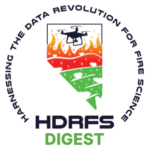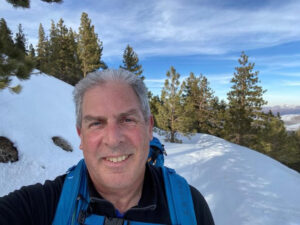Q&A: A gliding greenhouse for tracking carbon flux
Members of the Ecology component will be using the greenhouse to study how plant communities, including those dominated by invasive species, respond to and recover from fire.
By Amanda Heidt
May 2024
Across the West, invasive plant species like cheatgrass are crowding out and otherwise outcompeting native plant communities, leaving scientists wary of potential ecosystem disruptions. Diverse, healthy plant communities are thought to be more resilient in the face of fires and climate change than degraded habitats dominated be fewer species, but it’s not fully understood, for example, whether an invaded plant community stores carbon in the same way as an intact, native community does, nor how long it takes for an ecosystem’s ability to absorb CO2 to return after sagebrush habitats burn.
Jay Arnone, a plant ecologist at the Desert Research Institute in Reno, heads the Ecology component of HDRFS and recently presented updates on the group’s progress at the annual meeting in Las Vegas. Among their many initiatives is one that aims to address this question—a greenhouse mounted on tracks that the group plans to roll across the desert, collecting valuable data on carbon dioxide fluxes across a gradient of sagebrush habitats. Below, Arnone speaks more about the process of developing this new tool and the experiments the team is preparing to run in the coming months.
As a plant ecologist, how did you first get interested in fire, and how does a fire regime play into healthy ecosystem functioning?
When I first moved to Reno, deserts were new to me, but the thing that quickly became apparent was that invasive species were a big factor in the ecology of desert shrublands. Invasive grasses, for example, affect the natural fire cycle, which is how I got into this whole fire question. We started looking into whether an ecosystem with invasive species functions differently from a system that’s uninvaded. We came up with some ways to measure the carbon flux—the actual movement of carbon dioxide in and out of a system—to test how an ecosystem moves things around and how the interactions among organisms play into that. And I’ve been doing that for 20 years now.
What tools did you use early on to study these questions?
At first, we employed a system called a static chamber, where you plunk a container—we used a yurt tent—down on an ecosystem to measure the changes in CO2 concentration inside the chamber over time and calculate how much carbon dioxide is coming in during the day and going out at night. We did a lot of manual measurements, taking snapshots over a 36-hour period once a month to come up with a total for the whole year. But the problem is you have all these gaps in between the periods where you’re measuring, and it’s also very labor intensive to pick up a yurt tent. It’s only 30 pounds for two people, but you’re doing that for 36 hours straight.
We also started out sampling different pieces of the ecosystem, measuring the soil separately from each different kind of plant and trying to patch them together. But ultimately we decided to make something big enough to actually encompass the whole ecosystem and dispense with the patching. Something like an automated system.

The gliding greenhouse for tracking carbon flux that is being developed by the HDRFS team. (Credit: Jay Arnone)
Something like a greenhouse on wheels?
Well, on a track, but that’s the general idea.
Tell me about it.
We’ve landed on a redesign of an initial pilot greenhouse that had a few issues with things like leaks. Basically it’s a frame, a gantry, that holds the greenhouse, and we know the greenhouse doesn’t leak because we can seal it to the ground. The gantry is automated, and it moves the greenhouse from one plot to another on a 300-meter track and does the gas sampling for us, and it’s designed to run 24/7 during every season.
Our entire study area burned in 1984, and a more recent scar resulted from a wildfire in 2020. We’re interested in how the plant community in a plot—either one that’s been burned and coming back as an invasive species-dominated system versus one that looks like what it might have been like before human settlement—affects carbon dioxide flux before a fire, and then how does that plant community affect the fire severity and the recovery after. Our study is unique because we’ll know precisely what the plant composition and fuel amounts are before we experimentally burn half of our plots. Normally we have to make our best guess. Based on our past work in the Mojave, we know that shrublands can sequester more carbon than we ever thought they could, but invasive species can change that balance. I don’t know what to expect, but I am guessing they’ll be net CO2 sinks if you integrate over the course of a year.
You’ve built this prototype and are currently laying the tracks at the field site. What are your goals over the next year or so?
The main goal is to finish installing the track system and get the mobile chamber running. We can then start to answer these questions that ultimately may help land managers better determine which between-fire plant communities can be treated using prescribed fire or other methods to reduce cheatgrass fuel loads and promote return of the sagebrush ecosystem to its pre-invaded state.
 Special Issue of HDRFS Digest, a quarterly publication of the Harnessing the Data Revolution for Fire Science Project, which is a five-year research project funded by the National Science Foundation’s Established Program to Stimulate Competitive Research “EPSCoR” (under Grant No. OIA- 2148788) focusing on enabling healthy coexistence with wildland fire and the mitigation of wildfire danger to human life, infrastructure, and the landscape in Nevada and the intermountain western U.S.
Special Issue of HDRFS Digest, a quarterly publication of the Harnessing the Data Revolution for Fire Science Project, which is a five-year research project funded by the National Science Foundation’s Established Program to Stimulate Competitive Research “EPSCoR” (under Grant No. OIA- 2148788) focusing on enabling healthy coexistence with wildland fire and the mitigation of wildfire danger to human life, infrastructure, and the landscape in Nevada and the intermountain western U.S.

 Acknowledgement: This material is based upon work supported by the National Science Foundation under Grant No. OIA- 2148788.
Acknowledgement: This material is based upon work supported by the National Science Foundation under Grant No. OIA- 2148788.